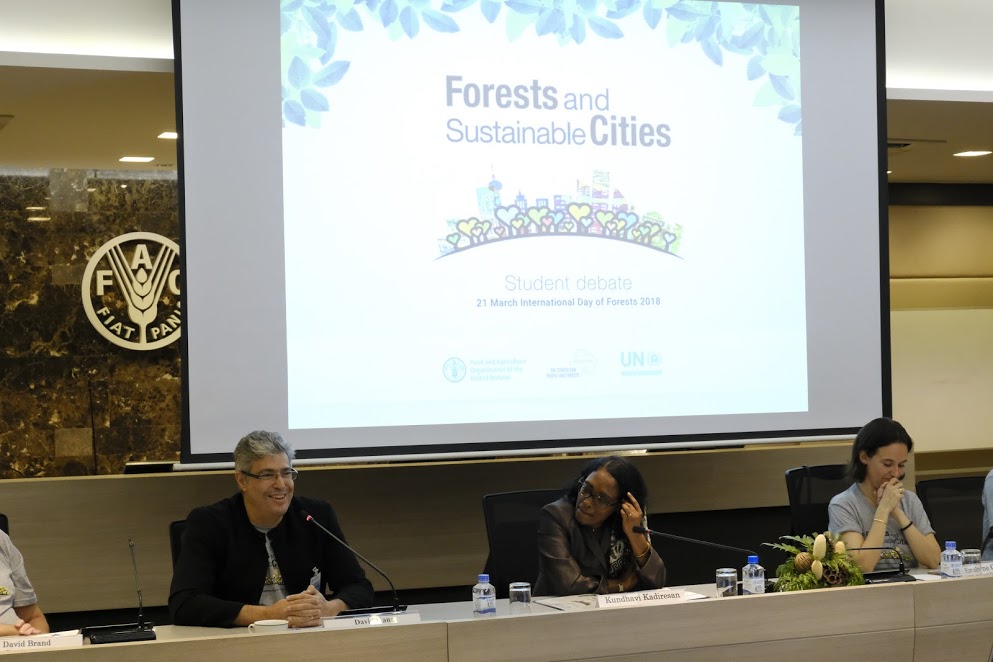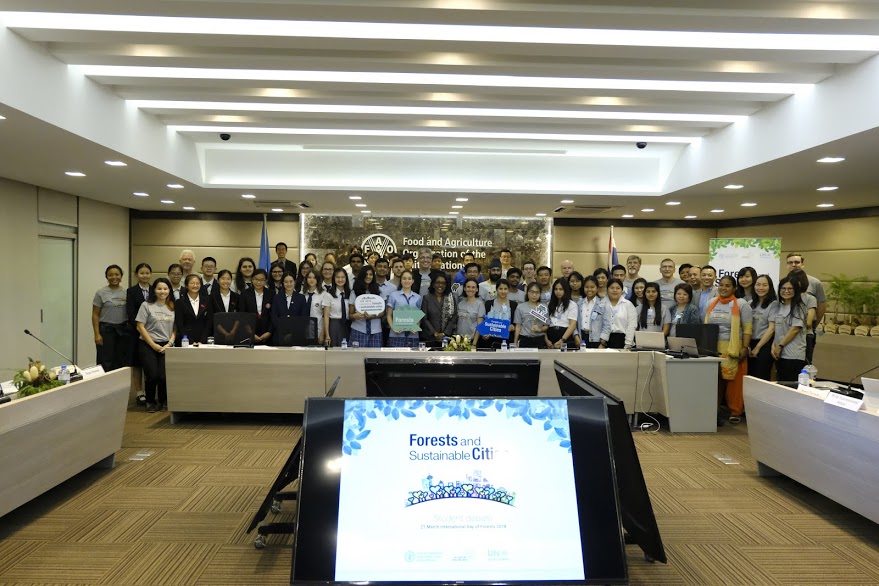Urban Forests and Sustainable Cities: Encouraging Youth to Think About a Greener Future

Earlier this week, I was fortunate to participate in the opening of the 5th Annual Student Debate on forests and sustainable cities hosted by RECOFTC – The Center for People and Forest, and our colleagues from FAO and UNEP. This event, which included eight schools –ranging from middle school to University—in Bangkok, Thailand, has been used as a fun and engaging celebration of the International Day of Forests for the past five years. Following this year’s theme, I spoke of my work as a community forester on an urban New Haven Ecology Project now called the Common Ground School. My intent with these opening remarks was to establish a personal connection between urban forestry and sustainable cities, hoping the students could as well. This in turn helped contextualize my final insights, which sought to provide advice about the profession and the potential that these young talented students have in contributing towards the diverse field of forestry. As the Executive Director of RECOFTC, and thus a potential future employer, I hope they explore the field further and provide a fresh perspective.

I listened intently while the students had a spirited debate on the pros and cons of using urban forests for mitigating climate change, including its contributions to a healthier life-style. These debates reminded me of the difficulties within our region for proper urban planning, especially as urban sprawl absorbs future human populations. I was also reminded of a few field seasons during my early career measuring trees in Sacramento, California. This information was subsequently used to maintain an urban tree database and contain Dutch Elm disease from spreading. This anecdote reminds me that Urban forestry around the world shares the challenge of maintaining viable tree health in what can be a very stressful environment for trees to flourish.
This anecdote reminds me that Urban forestry around the world shares the challenge of maintaining viable tree health in what can be a very stressful environment for trees to flourish.
These environments will become even more stressful in the upcoming decades due to the fact that our cities and suburban areas are the places that will absorb future human populations more than any other landscape. Regarding how to manage a landscape in a sustainable manner, these population increases present both opportunities and challenges for urban centers. Opportunities exist because cities have the critical mass to support the infrastructure improvements necessary to reduce carbon and ecological footprints, create social cohesiveness and foster economic growth. The challenge, however, is how to transform urban buildings and infrastructure so that they are consistent with sustainability goals, do not significantly disrupt the regional economy, and maintain the community’s fabric and integrity of urban open spaces.
RECOFTC sees these challenges as being similar to what community foresters and Forestry Departments face when involving stakeholders from all affected land-use sectors and applying participatory decision-making processes to strengthen rural livelihoods and ensure healthier forest landscapes. Similarly, urban architects and land-use planners must take into consideration a wide variety of disciplines when considering what species to plant, where to aggregate trees to form contiguous canopies and what risks to attempt to mitigate when creating open space (including transportation corridors, public safety, and appropriate water drainage). All of these issues and more were debated by the students during their debating stances for and against the planting of more urban trees.
As the Executive Director of RECOFTC, we are also debating what our role should be towards advancing urban forestry within the Asia and the Pacific region. This includes where and how participatory approaches can improve co-management models in urban settings. Community forestry includes a variety of institutional arrangements such as: indigenous management of sacred sites that are cultural important; direct community control or management of forest areas; small-scale forest-based enterprises; forest out-grower schemes; company-community partnerships; and other forms of decentralized and devolved forest management. All of these co-management models can provide valuable lessons learned for better urban planning and collaboration in what can sometimes be a hectic and stressful living environment. By supporting and assisting government, non-government, and community partners, RECOFTC has shown that community forestry and related approaches can deliver results that both improve livelihoods and safeguard the environment, especially in urban arenas where safeguarding the environment and urban forests can increase awareness of what is happening in rural areas.
As I sat there at the United Nations Food and Agriculture Organization’s (FAO) regional office for Asia and the Pacific listening to the student debate, it occurred to me that I had heard these same arguments under many different socio-economic contexts. I had heard them when discussing the need for expanding countries to find a balance between the demand for high value property and green open spaces. I had also heard them from those countries that are now developing plans for urban growth and beginning to accommodate migration patterns. Nonetheless, it is clear that we are all interested in poverty alleviation approaches that will not only produce tangible benefits, but also reduce our carbon footprints. I believe this comes from a desire to maintain social cohesiveness and foster economic growth without degrading the resource base, even in urban environments. Therefore, this is one debate that I will enjoy entering into for many years to come.


